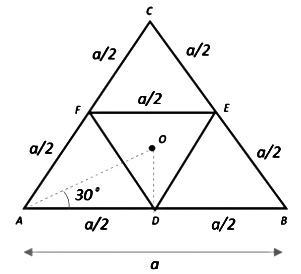Assume that mass of an equilateral triangle is concentrated about its vertices and first determine the moment of inertia of the entire lamina by finding the distance between the lamina’s centre and its vertices. Then determine the moment of inertia of the triangle DEF that is cut out, using the same assumption about mass concentrated at its own vertices and arrive at an expression for it in terms of the moment of inertia of the entire lamina. To this end, calculate the difference between the two moments of inertia thus obtained to arrive at the appropriate result for the rest of the lamina.
Formula Used:
Moment of inertia \(I=\Sigma m r^{2}\)
Let the length of the sides of the equilateral triangular lamina \(\mathrm{ABC}\) be \(a\), and let the mass of the entire lamina
be \(m\). Assuming that the mass of the lamina is concentrated about its vertices, the distance of the axis of rotation from the massive vertices can be found.
Let the distance of the axis of rotation \(\mathrm{O}\) to one of the vertices \(\mathrm{A}\) be \(\mathrm{OA}\), as shovn in the figure. Since \(\triangle A B C\) is equilateral, vie have \(\angle C A B=60^{\circ}\). The line drawn from \(\mathrm{O}\) to \(\mathrm{A}\) bisects this angle in such a way that,
\(\angle O A D=30^{\circ}\)
From right-angled \(\triangle O A D\), we have:
\(\cos 30^{\circ}=\frac{A D}{O A}\)
\(\Rightarrow O A=\frac{A D}{\cos 30^{\circ}}=\frac{\left(\frac{a}{2}\right)}{\left(\frac{\sqrt{3}}{2}\right)}=\frac{a}{\sqrt{3}}\)
Therefore, the moment of inertia \(I_{0}\) of the lamina acting about its centre due to all 3 of its massive vertices,
with an axis perpendicular to its plane can be given as:
\(I_{0}=\Sigma m r^{2}=3 \times m(O A)^{2}\)
\(=3 \times m \times\left(\frac{a}{\sqrt{3}}\right)^{2}\)
\(=3 \times \frac{m a^{2}}{3}=m a^{2}\)

Now, we are given that a cavity DEF is cut from the lamina in such a way that the points \(D, E\) and \(F\) are the midpoints of sides \(\mathrm{AB}, \mathrm{BC}\) and \(\mathrm{AC}\) respectively as shown. This divides the lamina into 4 equilateral triangles such that each equilateral triangle has a mass of:
\(m^{\prime}=\frac{m}{4}\)
We now find the moment of inertia of \(\Delta D E F\) about the same axis of rotation, as we did for the entire lamina. Let the distance of the axis of rotation from one of the vertices of DEF be OD.
From \(\triangle A O D\) we have:
\(\sin 30^{\circ}=\frac{O D}{O A}\)
\(\Rightarrow O D=\sin 30^{\circ} \times O A=\frac{1}{2} \times \frac{a}{\sqrt{3}}=\frac{a}{2 \sqrt{3}}\)
Therefore, the moment of inertia of the equilateral triangle DEF due to all 3 of its massive vertices will be:
\(I^{\prime}=3 \times m^{\prime}(O D)^{2}=3 \times \frac{m}{4} \times\left(\frac{a}{2 \sqrt{3}}\right)^{2}\)
\(\Rightarrow I^{\prime}=3 \times \frac{m}{4} \times \frac{a^{2}}{12}=3 \times \frac{1}{48} \times m a^{2}=\frac{1}{16} \times m a^{2}\)
But we know that \(I_{0}=m a^{2}\),
Therefore, \(I^{\prime}=\frac{1}{16} \times I_{0}=\frac{I_{0}}{16}\)
Once this part is removed from the lamina, the moment of inertia of the remaining part of the lamina about the same axis will be:
\(I=I_{0}-I^{\prime}=I_{0}-\frac{I_{0}}{16}=\frac{16 I_{0}-I_{0}}{16}=\frac{15 I_{0}}{16}\)


 Get latest Exam Updates
Get latest Exam Updates 
 ×
×
















